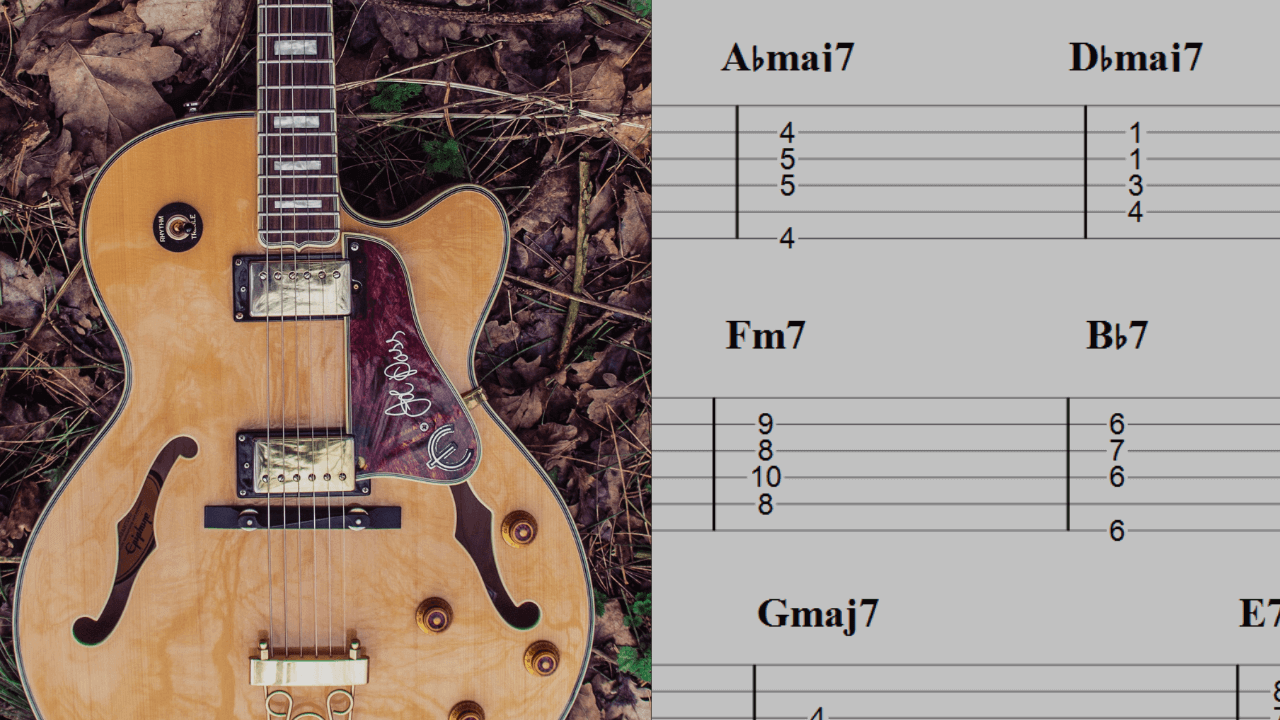It’s no surprise that “neo-soul” guitar is becoming a buzz word in the online guitar community as R&B is a style of music that is here to stay.
Its timeless appeal started with Ray Charles, migrated to the guitar with Jimi Hendrix and others, and then found its way into hip-hop and modern R&B music.
This is because it combines many of the best elements of songwriting fundamentals as well as pretty chord progressions using voicings from the Jazz world.
Every guitarist who wants to improve their chord knowledge should delve into the 20 plus r&b chord progressions we’ve got in store for you right here.
Table of Contents
- I – III – (IV-III-bIII) – II In G major
- (ii – V7) – (iii7 – vi7) – I7 In A Major
- 12 Bar Blues in F Minor
- I – I – V7 – V7 – I – I – IV – I – I in A Major
- iv7 – i7 In C# Minor
- i7 – ii7 – i7 – ii7 in F# minor
- i7 – IV7 – VII7 – VI in C# Minor
- I – vi – iii – V in F Major
- i – VI – iv – (iv – #VII7) in C Minor
- I – IV in C Major
- (IVmaj7 – ii7) – (iii7 – vi) to (II – II – I6 – IV) in D Major
- Imaj7 – V – bVIImaj7 – IV in Eb Major
- I – (IV – I) – (iii-vi) – (IV – V7) in Bb Major
- I – I – vi – vi – IV – IV – V – V in D Major
- I – I – V – V – ii – ii – IV – V in C Major
- I – vi7 – I – vi7 – (vi7 – v) – ii7 – I in F Major
- i – (i – v) – iv – (iv – VII) in C#m minor
- i – VI – VII – III – i – IV – VII – VI – III – VI – bII – bII – I – I in A Minor
- i – V7 – VI – IVdim7 in G# Minor
- i – (i – bII) in F Minor
- ii7 – ii7 – IV – IV – iii7 – iii7 – iii7 – (iii7 – VI7) in C major Or D Dorian
I – III – (IV-III-bIII) – II In G major
“Sitting On The Dock Of The Bay” by Otis Redding is the first song we’re going to break down in this article as it’s one of the most famous around. The song is particularly famous because Otis recorded the vocals as a demo and didn’t have a chance to properly record a final version. He died only a few days after recording the version we now know.
G – B – (C – B – Bb) – A are the chords you’ll get when you pick the chords according to the roman numerals above.

When we break down the chords in G major we’ll get the following:
G major scale = G (W) A (W) B (H) C (W) D (W) E (W) F# (H) – G
G chord (I) = G – B – D
Am chord (ii) = A – C – E
Bm chord (iii) = B – D – F#
C chord (IV) = C – E – G
D chord (V) = D – F# – A
Em chord (vi) = E – G – B
So the B, Bb, and A chords are not a part of the key. They’re what I call “foreign chords” as they don’t come from modal mixture or any similar major scales. The D# in B and the Bb root note in the Bb chord, for instance, don’t appear in the G major scale.
This is one of the great things to keep in mind when you’re creating chord progressions as many of us work hard to understand major scales and chord progressions, but forget that we don’t have to stick closely to this concept. We’re free to choose chords outside of this or any key we’re playing in.
(ii – V7) – (iii7 – vi7) – I7 In A Major
The following progression is another one of the most famous progressions in R&B music from Earth, Wind, & Fire’s “September”:
(Bm7 – E9) – (C#m7 – F#m7) 3x then A13

In this progression, the band is using what’s called a ii – V progression. This is a very common move in Jazz music and R&B music as in this case the Bm7 is a relative V chord to E. The relationship between I and V is the strongest in music as it establishes a key signature like A Major:
A major scale = A – B – C# – D – E – F# – G#
A13 (I7) = A – C# – E – G – F#
Bm7 (ii7) = B – D – F# – A
C#m7 (iii7) = C# – E – G# – B
F#m7 (vi7) = F# – A – C# – E
So you can see that most of these chords, except A13, sit perfectly in the key of A major. A lot of times you can’t go wrong by taking the chords available in any major key and making some chord progressions. However, remember that you don’t always have to do that like we saw in the Otis Redding song before.
To continue on the I-V concept, instead of going from E to A the ii-V is going from Bm to E. If we were in E major, the I-V would be E to B. See how similar they are? That’s what Jazz is using all of the time and what you can start using too.
The iii7 – vi7 has a similar relationship as well because C#m is the relative v chord to F#m.
12 Bar Blues in F Minor
This very long progression is a 12 bar blues in F minor from the song “Green Onions” by Booker T & The MGs:
(F5 – Ab5 – Bb5) 4x then (Bb5 – Db – Eb) 2x then (F5 – Ab5 – Bb5) 2x then (C – Eb – F) – (Bb5 – Db – Eb) to (F5 – Ab5 – Bb5) 2x

Booker T and The Mgs were the session band for Stax records in Memphis. Steve Cropper, the guitar player, actually co-wrote “Sitting On The Dock Of The Bay” with Otis Redding. All the guys would have a major hand in penning many of the songs at Stax that would top the charts.
This song uses a very familiar chord progression from the Blues. Count the bars above and you’ll see that it adds up to 12 total. The blues part comes from the use of the I chord for the first 4 bars and later on, then the Bb chord for 2 bars and later too, and then finally the C chord for 1 bar.
I – IV – I – V – IV – I – (blues turnaround)
This is the format for many blues songs and why the term “12 Bar Blues” was termed. Most musicians should know what you mean when you say it’s a 12 bar blues in F minor.
Let’s break down the F minor key so you can see where the IV and V chords come from, as well as the other chords in the mix:
F minor scale: F – G – Ab – Bb – C – Db – Eb
Fm (i) = F – Ab – C
Bb (iv) = Bb – Db – F
C (v) = C – Eb – G
The chords are played as power chords because most blues songs won’t use the minor chords seen above that are diatonic to F minor. Playing power chords keeps the song more harmonically neutral without the darkness of minor or the brightness of major.
I – I – V7 – V7 – I – I – IV – I – I in A Major
The next example is a chord progression from Ray Charles “I’ve Got A Woman” in A Major:
A6 – A6 – E7 – E7 – A6 – A6 – D7 – A6 – A6

This one is very similar to the 12 bar blues format but not quite as strict to the formula. You’ll see that it goes to V (E7) before going to IV (D7) and back to A6. Although I’ve been knocking the tendency to stick with these 3 harmonies, there are plenty of ways to add variety to the progression.
Notice also that the progression is using a D7 chord, which contains C natural and is not a part of the A major scale. Here it is again for reference:
A major scale = A – B – C# – D – E – F# – G#
A6 (I) = A – C# – E – G – F#
E7 (ii7) = E – G# – B – D
D7 (IV7) = D – F# – A – C
There will be many times when, like earlier, chromaticism won’t come from a parallel mode but this is not the case. The C natural in D7 does come from A minor, which is the parallel minor key to A major.
This is a common use when creating chord progressions because the harmonies in A major and A minor overlap and don’t differ by many sharps. By sharps, I mean that A major has 3 sharps total (F#, C#, and G#) while A minor has none (all natural notes).
The combination of C# (major 3rd) and C (minor 3rd to A) in particular is another use of blues/jazz harmony. Any time you see a chord using these intervals together in some way is a sign that the songwriter was going for this type of sound.
iv7 – i7 In C# Minor
This chord progression comes from “The Boy Is Mine” by Brandy & Monica and it’s in E major/C# minor:
F#m9 – F#m9 – C#m9 – C#m9

Here’s the scale and a few chords for reference:
C# minor scale = C# – D# – E – F# – G# – A – B
C#m9 = C# – E – G# – B – D#
F#m9 = F# – A – C# – E – G#
As you can see, a m9 chord uses 5 chords and only leaves two notes left in the key to use. So just playing these two notes can imply the key signature very well.
In R&B and many types of music, you will see lots of chord progression that just use one or two chords for a riff or a progression. It’s okay to do that whether the progression implies the key signature or not.
Notice so far that you’ve seen m9s, 6s, a 13, and other voicings that will be used often in this genre.
i7 – ii7 – i7 – ii7 in F# minor
This next chord progression is Michael Jackson’s “Billie Jean” in F# Minor:
F#m7 – G#m7/F# – F#m7 – G#m7/F#

F# minor is the relative minor to A major so you should be familiar with and understand the chords being used quite well.
One thing to keep in mind with all of these chord progressions is that you must pay attention to what the “top voice” will be. The point of using so many voicings is to be able to have a different note act as the melody note.
For instance, in this song the riff melody is going from F# – G# – A and back down. In the tab, I arranged the voicings so that we’re playing these notes on the high E string.
The more conscious of this you become, the better you’ll get at choosing chords that reflect the sound of the melody and the progression.
i7 – IV7 – VII7 – VI in C# Minor
This chord progression is from Stevie Wonder’s “Isn’t She Lovely” in C# Minor:
C#m7 – F#9 – B11 – E

This progression has been very popular amongst guitar players over the past several years as it fits well on the fretboard, and is a great framework for using tapping and percussion techniques.
Notice that this one is also using Jazz voicings we mentioned earlier, but only uses 4 bars. So remember it’s okay to write short chord progressions if that’s what you want.
I – vi – iii – V in F Major
This chord progression is Etta Jame’s “At Last” in F Major:
(F – Dm7) – (Gm7 – C7)

This one is squarely in the key of F major and follows the patterns of many progressions that came out in the late 50s and early 60s. This is because using some combination of I, vi, and V was used a lot! Sometimes it would use IV instead of iii.
If you use this formula, you’re guaranteed to get the sound of this time and place.
i – VI – iv – (iv – #VII7) in C Minor
This chord progression comes from “Say My Name” by Destiny’s Child in C Minor:
Cm – Ab – Fm – (Fm7/Bb – Bdim7)

This progression is really neat because it 1) uses a bassline that goes from F down to Bb and then to B and 2) the use of the Bdim7.
There’s lots of confusion about diminished chords but there’s an easy way to remember how to use it. Bdim7 contains many of the same notes as Bb7, which is the VII7 of C minor.
Bdim7 = B – D – F – Ab
Bb7 = Bb – D – F – Ab
It can basically be used as a substitute for Bb7 and work anywhere that this chord can be used, which is in many places.
I – IV in C Major
This chord progression comes from “My Girl” verse progression in C Major:
C – F 3x

Remember the two chord vamps? This is one of the most basic but the most useful you can find in this genre. Part of the reason this always works great is because C is the relative V chord to F major, which will be the case with any I-IV progression in a major key.
(IVmaj7 – ii7) – (iii7 – vi) to (II – II – I6 – IV) in D Major
This very busy chord progression is from the chorus of “Ain’t No Mountain High Enough” in D major:
(Gmaj7 – Em9) – (F#m7 – Bm) 3x then (Esus4 – E – D/F# – G)

Lots of chords here but just like always you should compare it to your knowledge of the key it’s in. Everything fits in the key of D major except for the E major chord. You’ve seen many of these voicings before and we’ve already talked about this key signature so you’ve got this.
What’s important to keep in mind as to why this progression works so well is that it’s top voice stays in place pretty much the whole time. That’s why this song is so catchy!
Imaj7 – V – bVIImaj7 – IV in Eb Major
This chord progression is from the 90s classic “Waterfalls” by TLC:
Ebmaj7 – Bbadd9 – Dbmaj9 – Ab

Once again, many things you’ve seen so far, but one curveball. The Dbmaj9 is a bVII chord because the Db note doesn’t appear in the key of Eb major:
Eb major scale: Eb – F – G – Ab – Bb – C – D
Ebmaj7: Eb – G – Bb – D
Dbmaj9: Db – F – Ab – C – Eb
Fm7: F – Ab – C – Eb
Look closely and you’ll see that the Dbmaj9 has all the same notes as Fm7, which is diatonic to the key of Eb major. It’s why you’ll often see bVII chords in many R&B chord progressions.
I – (IV – I) – (iii-vi) – (IV – V7) in Bb Major
The next progression is the Supreme’s “You Can’t Hurry Love” in Bb Major:
Bb – (Eb – Bb) – (Dm – Gm) – (Eb – F7)

So far you’ve gone through lots of progressions that have one harmony per bar, but this one has us using 2 chords per bar for 3 bars total. This can be a little more challenging to write for, or to solo over, but there are many rewards from learning how to arrange a progression like this one.
As to where these chords came from, you can get them all from the key of Bb major:
Bb major scale: Bb – C – D – Eb – F – G – A
Bb: Bb – D – F
Dm: D – F – A
Gm: G – Bb – D
Eb: Eb – G – Bb
F7: F – A – C – Eb
The reason why we keep showing the breakdowns of the key and the chords is because a lot of the “secrets” to songwriting are right here. When you understand this, so many pieces of knowledge open up to you as a guitar player and a songwriter.
I – I – vi – vi – IV – IV – V – V in D Major
This chord progression comes from “Please Mr. Postman” in D Major by The Marvelettes:
D – D – Bm – Bm – G – G – A – A

When songwriting, you can also play a chord for more than one bar. As guitar players, we want the challenge of tricky chord changes played quickly after each other, but melodies often won’t work with this.
A better idea is to take a few chords, and spread them out over 8 bars or more like this song does.
I – I – V – V – ii – ii – IV – V in C Major
This progression is “Can’t Help Myself” by The Four Tops in C Major:
C – C – G – G – Dm – Dm – F – G

Everything is right within the key of C major and uses the same ideas of spreading out the chords across a few bars. Use this example!
I – vi7 – I – vi7 – (vi7 – v) – ii7 – I in F Major
This progression is “Signed, Sealed, Delivered” by Stevie Wonder in F Major.
F – Dm7 – F – (Dm7 – Cm/F) – Gm7/C – F

Don’t be afraid to reuse the same chords either. This song does that with F and Dm7.
What’s really interesting about this progression is the use of Cm/F because there’s no Eb in F major. Using a minor V chord or a minor IV chord are two great moves to use in all sorts of progressions and not just R&B.
i – (i – v) – iv – (iv – VII) in C#m minor
This more modern classic is Ginuwine’s “Pony” in C#m minor:
C#m – (C#m – G#m) – F#m – (F#m – B5)

It’s a pretty simple melody that follows the scale of C#m minor to a T. When playing this progression yourself, you can avoid using the minor chord voicings as this won’t sound similar to the song. Powerchords will work!
i – VI – VII – III – i – IV – VII – VI – III – VI – bII – bII – I – I in A Minor
This progression is Roberta Flack’s “Killing Me Softly With His Song” in A minor:
Am – F – G – C – Am – D – G – F – C – F – Bb – Bb – A – A


What’s important to notice here is that the D chord, Bb chord, and A chords don’t belong to the key. The Bb works because F is the relative V chord, while D works because Am is the relative v chord to D. Remember that the V-I change is the most integral in all music.
i – V7 – VI – IVdim7 in G# Minor
This is Justin Timberlake’s “Cry Me A River” in G# minor:
G#m – D#7b9 – E – C#dim7

The 7b9 chord is used a lot in Jazz and works great as a V chord. The C#dim7 shows another great use of a dim7 chord as the G note (the diminished 5th) increases the need to resolve back to G#m. Add this to your knowledge of using dim7 chords!
i – (i – bII) in F Minor
We had to include Montell Jordan’s “This Is How We Do It” in F minor:
Fm – (Fm – Gb)

You saw the use of a bII chord earlier in Roberta Flack’s song, but this one doesn’t have the V-I relationship. The bII is a great way to bring the phrygian mode sound as the mode is based around the major chord at II.
ii7 – ii7 – IV – IV – iii7 – iii7 – iii7 – (iii7 – VI7) in C major Or D Dorian
The final progression is “That’s What I Like” by Bruno Mars in D Dorian/C Major:
Dm9 – Dm9 – F/G – F/G – Em7 – Em7 – Em7/A – (Em7/A – A9)

This progression could be confused for being in D minor, but this is a mistake if you don’t see the lack of a Bb note:
- D minor scale: D – E – F – G – A – Bb – C
- D dorian: D – E – F – G – A – B – C
- C major: C – D – E – F – G – A – B
Don’t worry if you didn’t catch this as the way modes are taught a lot is confusing. All you need to understand this progression is that the chords all come from C major/D dorian and not D minor/F major. It’s again why we need to study key signatures and chords as much as scales.
Loves studying classical piano, youtube video tabs, and music theory textbooks to get insights into guitar playing that no one else has uncovered yet. In his spare time, he can be found relaxing at the beach in San Diego, or adventuring somewhere around the world.




